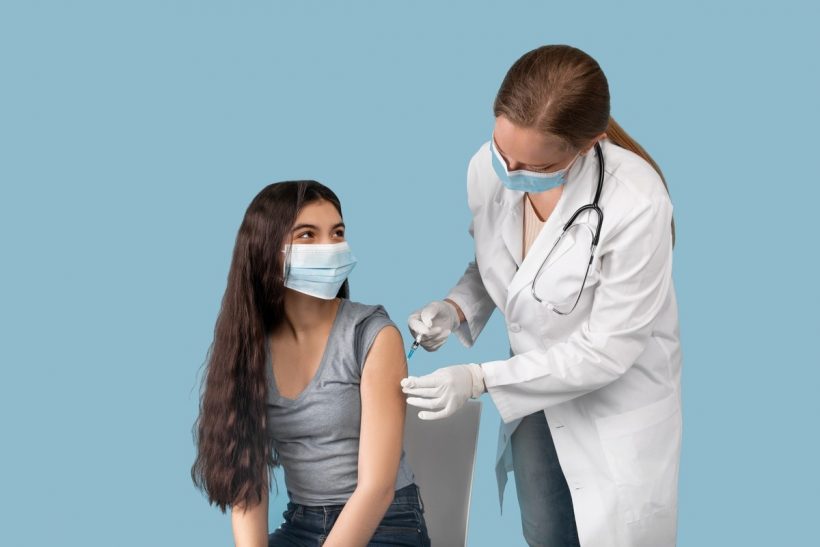In a recent study posted to the medRxiv* preprint server, researchers evaluated Pfizer-BioNTech’s BNT162b2 vaccine effectiveness (VE) after two and three doses against severe acute respiratory syndrome coronavirus 2 (SARS-CoV-2) variants of concern (VOCs) such as Delta and in Canadian adolescent community residents.

Background
BNT162b2 vaccinations authorized for use among adolescents over 16 years were extended to Canada and the United States (US) in May 2021 to include 12- to 15-year-olds. Double BNT162b2 vaccination demonstrated >90% efficacy in phase III trials against SARS-CoV-2 infections among adolescents up to four months of the second vaccination.
To this end, the national advisory committee on immunization (NACI) advised longer intervals between the first and the second vaccine doses from March 2021 in British Columbia (BC) and Quebec provinces of Canada. Furthermore, triple BNT162b2 vaccinations for adolescent individuals commenced in February 2022 in the two Canadian provinces.
About the study
In the present study, researchers evaluated double and triple BNT162b2 messenger ribonucleic acid (mRNA) VE against Omicron and Delta among adolescents residing in the BC and Quebec provinces of Canada with the initial and subsequent vaccine doses > three weeks apart and a test-negative design (TND).
BNT162b2 VE was assessed against nucleic acid amplification test (NAAT)-confirmed coronavirus disease 2019 (COVID-19) for teenagers aged 12 to 17 years (cases) between 5 September 2021 and 30 April 2022. For comparison, NAAT-negative adolescents (controls) were analyzed. The period of Delta predominance was considered between 5 September and 27 November 2021 and Omicron predominance between 19 December 2021 and 30 April 2022.
Vaccination details were provided by the COVID-19 surveillance registries of the two Canadian provinces. VE was evaluated for two weeks by the dosing interval between the two vaccine doses and the time elapsed after the second vaccination and with the third vaccination dose. Logistic regression modeling was used, and the adjusted odds ratios (AORs) were estimated for COVID-19 among double and triple BNT162b2 vaccinated adolescents compared to unvaccinated ones.
Covariates such as age, sex, region, and calendar time. The regions included 18 geographical regions of Quebec, grouped into five sites (Greater Quebec City, Greater Montreal, Northern Quebec, Central Quebec, and other regions) and five regions in BC (Interior, Fraser, Vancouver Island, Northern, and Vancouver Coastal).
Results
In BC and Quebec, the team sampled 60,903 and 193,899 adolescents, respectively, of which, 11% (n=6,673) and 11% (n=20,570) adolescents, respectively, were NAAT-positive, including 0.9% (n=59) and 0.8% (n=159) hospitalized adolescents, respectively. The percent positivity was lower among vaccinated adolescents than unvaccinated adolescents, and no deaths were observed among the study participants. Most cases in Quebec (63%) and BC (68%) occurred after 20 weeks of the second vaccination, during the period of Omicron predominance.
The dosing interval between the first and second doses was eight weeks and between the second and third doses was 28 to 31 weeks. The mean follow-ups after the second vaccine dose during periods of Delta and Omicron dominance were 10 to 11 weeks and 21 to 22 weeks, respectively, and after the third vaccine dose was three to nine weeks.
In the transition (Delta-to-Omicron) period, VE was slightly lower at 83% in Quebec and 88% in BC. In the Omicron-dominant period, VE reduced further to 42% and 34%, respectively. In Quebec, adjusted two-dose VE was slightly higher against symptomatic COVID-19 during the Delta-dominant (97%), Delta-Omicron transition periods (88%), and more so in the period of Omicron dominance (55%).
VE against the Delta VOC was ≥90% up to five months after the second vaccine dose. In contrast, VE against the Omicron VOC reduced from 65% to 75% post two to three weeks to less than 50% within three months of vaccination, which bounced back to 60% to 65% within a short period after the third vaccine dose. VE exceeding 90% was observed against Delta irrespective of the dose intervals but improved against Omicron in ≥8 weeks interval between the first and the second vaccine doses.
VE estimates differed slightly (higher by ≤10%) for the Quebec province on restricting the analysis to only symptomatic adolescents, which reflected symptom-based SARS-CoV-2 testing in the Canadian provinces. For both the provinces, SARS-CoV-2 testing policies changed in mid-January to target those at high risk of severe COVID-19 outcomes, which may have influenced VE estimates against Omicron.
Vaccine cards or passports were mandatory for attending recreational or social settings for both provinces from September 2021 and lifted in mid-March (Quebec) or early April (BC), and this might have led to increased risk of exposure among vaccinated adolescents, potentially under-estimating VE. However, VE continued to be high through November and the period of Delta predominance.
Conclusions
Overall, the study findings showed that among adolescents, double BNT162b2 vaccination conferred robust and long-term immune protection against the Delta VOC but decreased with the rapid waning of VE against the Omicron VOC. However, longer dosing intervals between vaccine doses and the third vaccination enhanced protection against Omicron. Therefore, increasing the dosing intervals and the doses may enhance VE among adolescents against immune-evasive SARS-CoV-2 VOCs.
Further research with randomized controlled trials is required to assess the effects of confounding variables associated with the probability of SARS-CoV-2 infection and vaccination. Future studies must consider the size of households, the presence of younger siblings (not eligible for vaccination), and socioeconomic status and stratify data by comorbidities such as immunocompromised conditions.
*Important notice
medRxiv publishes preliminary scientific reports that are not peer-reviewed and, therefore, should not be regarded as conclusive, guide clinical practice/health-related behavior, or treated as established information.
- Ionescu, I. et al. (2022) "BNT162b2 effectiveness against Delta & Omicron variants in teens by dosing interval and duration". medRxiv. doi: 10.1101/2022.06.27.22276790. https://www.medrxiv.org/content/10.1101/2022.06.27.22276790v1
Posted in: Medical Science News | Medical Research News | Disease/Infection News
Tags: Adolescents, Coronavirus, Coronavirus Disease COVID-19, covid-19, Efficacy, Immunization, Nucleic Acid, Omicron, Research, Respiratory, Ribonucleic Acid, SARS, SARS-CoV-2, Severe Acute Respiratory, Severe Acute Respiratory Syndrome, Syndrome, Vaccine

Written by
Pooja Toshniwal Paharia
Dr. based clinical-radiological diagnosis and management of oral lesions and conditions and associated maxillofacial disorders.
Source: Read Full Article
